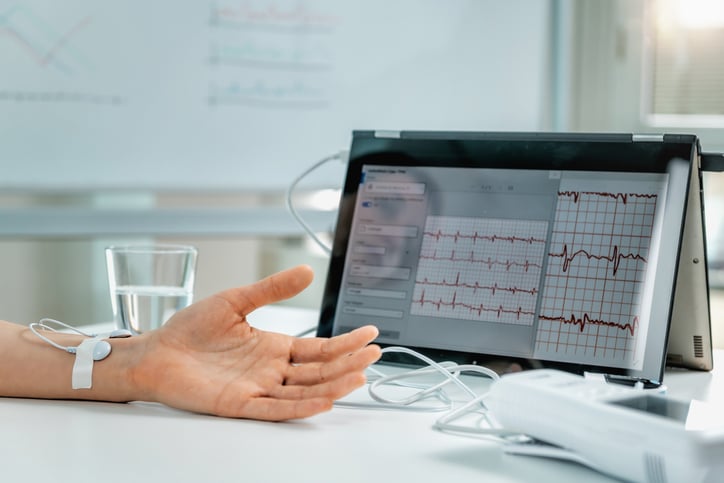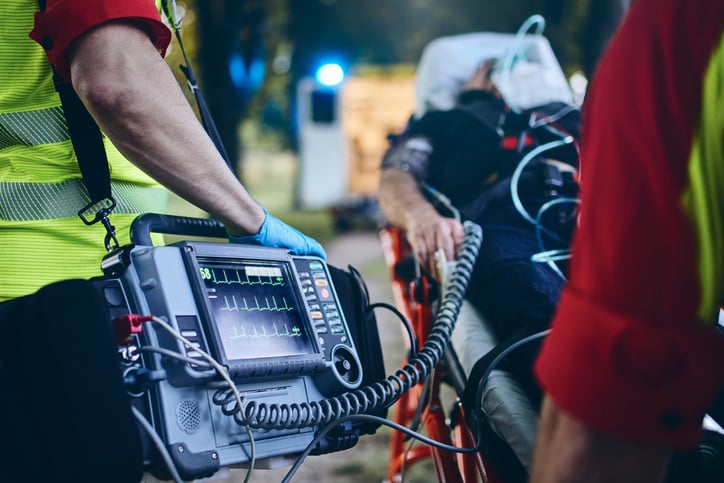Custom Integrated Medical Sensor Cost: What You're Investing In

A heart monitor that doesn't miss registering a patient's heartbeat.
An invasive blood pressure monitor taking critical vitals are regular intervals.
A thermometer used to take a temperature during initial intake.
These devices – lifesaving in some instances – are among the most common in almost every medical setting. And like any piece of equipment used in patient care, there's absolutely no room for error in their measurements or performance.
The medical equipment of today is a far cry from where it was even 20 years ago. Devices now used in patient care at all levels are more sophisticated than ever. They're also changing treatment and its delivery – remote patient care and wearable devices (something once thought only possible in science fiction) are now standards.
What makes the latest iteration of medical devices viable for patient care? In large part, custom integrated medical sensor technology.
Advanced sensors used in medical applications are not unlike those used elsewhere – say electric vehicles – in one major respect: cost.
Like most cutting-edge technology, integrating customized sensors into a device requires an investment. That should come as no surprise – premium technology carries a premium price.
Still, for medical equipment manufacturers and those who buy them, sensor costs for their devices are a concern, so much so that it's among the first questions asked during an engagement.
While the simple answer is the figure on the final bill, the value of customized medical sensor technology goes beyond a number.
Customized Integrated Medical Sensors: An Investment In What?
Before dissecting what drives the cost of custom medical device sensors, every product's price is relative to its value. Though customized sensor technology for medical devices may carry a bigger price tag, its value cannot be disputed.
With a custom sensor, you can rest easy that the measurement technology is designed to work exactly in sync with your medical devices. There's little worry about if – or more importantly, when – a retrofitted sensor will fail.
What's more, for a medical device manufacturer, integrated healthcare sensors also open the door for innovation in their product line. By having an engineered solution that integrates custom sensors into the existing design, they can offer new features and better capabilities in their products.
Still, sensor technology for medical devices is indeed an investment. To that end, sensors are not a place to cut costs. The last thing any doctor – or patient receiving care – wants to find out is that the equipment used to take readings is outfitted with sensor technology that's subpar.
Integrating custom sensors into your medical devices is an investment in:
- Accuracy – There's little question – medical devices need to measure accurately. Custom sensors bring a higher level of precision to a device's functionality as they're designed for it and not retrofitted to it.
- Stability – Just like the piece of equipment it's installed in, a medical sensor must work reliably and consistently over its useful life. Custom-integrated medical sensors give you peace of mind knowing they will not lose pace as long as they're in service.
- Robustness – Piggybacking off the last point, effective application of sensors in healthcare means they are able to withstand the environment they're in. This includes temperature, pressure, and vibration levels that can range from benign to extreme. It also includes cleaning – harsh solutions used to sterilize devices can be more damaging than long-term use.
- Support – The best custom sensors are made by manufacturers with experience and a proven track record. In other words, not just any sensor manufacturer can make a custom integrated sensor for healthcare. From design and engineering to customer support, top-tier custom sensor manufacturers provide a higher level of service. In most cases, you'll develop a 1:1 relationship with your manufacturer that extends long beyond the initial purchase.
What Drives the Price of Custom Integrated Medical Sensors?
Back to addressing the matter at hand – what comprises custom medical sensor prices?
Like custom sensors used in other applications, the sensor technology in healthcare and OEM medical devices see their costs driven by:
- Design and engineering
- Components
- Manufacturing
- Testing
- Certification
Let's take a close look at each.
1. Design & Engineering
Designing a patient monitoring sensor that's customized to work with a specific medical device is no small feat.
It requires a high level of expertise in not only the mechanics of the sensor and equipment but also the actual application of both. Everything from the sensor's architecture to its materials and components must be considered. Engineering teams also need to consider how their designs will interact with your medical device's hardware and software.
And because you're not buying a sensor off the shelf, so to speak, there's the time spent working directly with you through creating your sensor. To put it plainly, the standard back-and-forth it takes to create a customized sensor isn't different from medical instrument design and development – it takes time and careful consideration.
The sensor development process is very much an interactive one, which allows your sensor manufacturer to work closely with you in order to understand your specific needs and create a customized solution.
2. Components
One of the biggest contributors to a medical diagnostic sensor's cost is the components used to build it.
In most cases, the parts used have been carefully selected for their performance capabilities and quality. While the cost of these components can vary greatly, it's important to remember what you're investing in – stability, accuracy, and robustness.
And again, because your sensor is being designed for a specific application, its components need to be specially manufactured – bringing along longer lead times that increase the overall cost of production. Some sensor manufacturers are able to control this cost, namely those with in-house foundry services. After procuring the raw materials, they're able to build components in-house (from the sensor to the assembly) eliminating the need to bring in a third party.
The complexity of the sensor design also affects component cost. The complexity of the components used in a medical sensor will depend on what type of sensor it is, as well as its purpose. For instance, an electrocardiogram (ECG) sensor will have more complex components than a basic thermometer.
Put simply, complex designs require complex components, which can cost more.
3. Manufacturing
Unlike generic sensors, custom medical sensors must be designed and assembled with the utmost care and precision.
This can include everything from creating a prototypes for testing to producing the final product – all on par with the exacting healthcare standards. To meet these regulations, manufacturers must employ a range of special processing techniques such as micro-machining and laser welding.
Furthermore, medical sensors may require additional treatments such as annealing or plating to improve the durability and accuracy of the device. The entire manufacturing process is often subject to rigorous quality control tests to ensure that all components are compliant by government driven standards.
4. Testing
Speaking of testing ...
Like any piece of medical equipment, long before a device used in patient care makes its way to market, it must first undergo extensive testing.
Medical device testing is an incredibly exhaustive process designed to ensure that devices used in patient care are safe, accurate, and reliable. Every aspect of the device must be tested, from the materials and components used in construction to its performance under various simulated conditions. Tests include electrical safety assessments such as:
- Insulation resistance
- Ground continuity
- Dielectric strength
- Communication tests (to make sure the device can interface with others)
- Environmental tests for factors including vibration, temperature, & pressure
Testing happens in specialized laboratories where the conditions are precisely controlled. The testing process may also involve clinical trials in which a small group of patients use a device to assess its performance in a real-world medical setting
Keep in mind – not every sensor manufacturer has the capability to complete testing in-house. Those that don't have to go elsewhere or put the onus on you to find a solution.
5. Certifications
Hand-in-hand with testing comes a device's certifications.
Perhaps more than any other device, those used in patient care must meet strict standards and regulations. Rightfully so – treating patients is the last place you want to introduce a faulty device. Certifications are the literal proof that a medical instrumentation system or device is up to par.
Like most other devices, medical equipment these days is rarely made without third-party components – even if it's something as simple as a LED screen. In the eyes of regulators, all it takes is one component not meeting standards for an entire device to be out of compliance.
The type of certifications required for your medical sensor will vary depending on where and how it will be used – though similar in many cases, the U.S. has very different certifications than, say, the European Union.
Getting the Most for Your Money | Medical OEM Sensor Manufacturers
Again, custom integrated medical sensors do indeed cost money and what comprises that price is worth asking an OEM sensor manufacturer about.
An experienced medical sensor manufacturer is an invaluable asset when it comes to getting the most out of your investment. With their expertise, they can help you identify the right components for your sensor's design and make sure that they meet all relevant quality standards. They understand the importance of controlling costs while still delivering a product that meets its intended purpose.
A reputable medical sensor manufacturer that's up-to-date on the latest regulations, technologies, and certifications is worth its weight in gold and can ultimately help you streamline the entire sensor procurement and integration process.
Custom Integrated Medical Sensors: A Worthwhile Investment
When you think of the life-saving work medical devices do, it's hard to put a price on everything that goes into them.
Still cost is a necessary consideration of medical devices & sensors.
From design and engineering to components, manufacturing, testing, and certifications – investing in custom integrated medical sensors is just that – an investment.
The good news is – like any other investment – there's absolutely a return from integrating custom sensors into your medical device. This return comes in the form of the equipment's ability to perform exactly as it should and help healthcare professionals do their jobs effectively.



